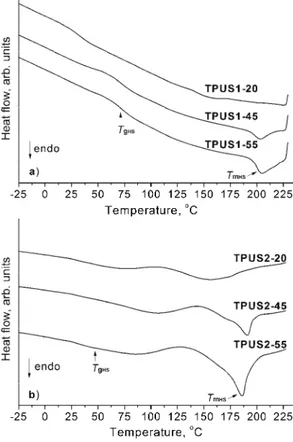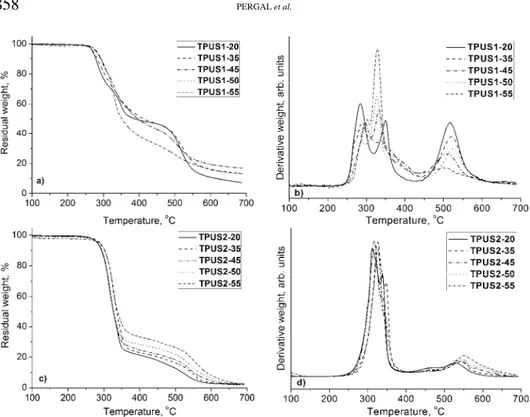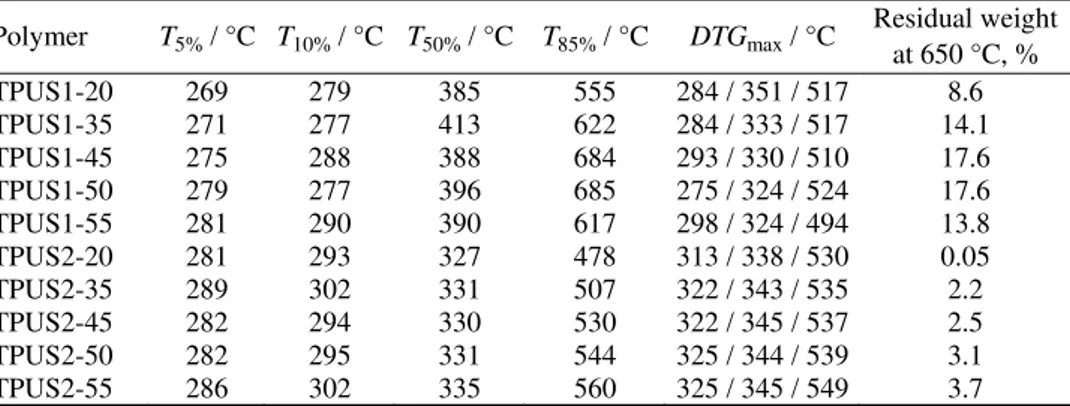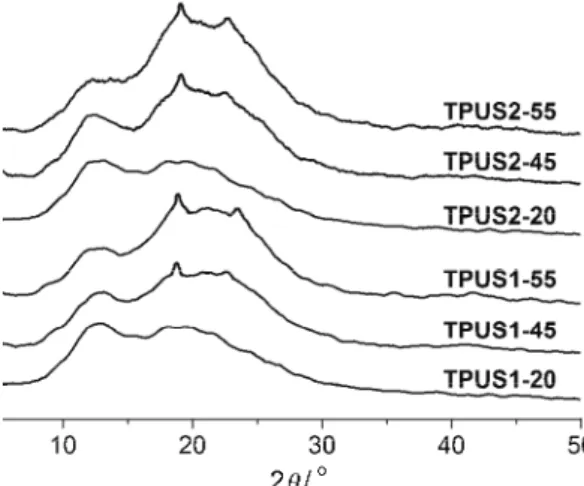JSCS–4631 Original scientific paper
Structural, thermal and surface characterization of
thermoplastic polyurethanes based on poly(dimethylsiloxane)
MARIJA V. PERGAL1*#, IVAN S. STEFANOVIĆ1, DEJAN GOĐEVAC1, VESNA V. ANTIĆ2, VESNA MILAČIĆ3, SANJA OSTOJIĆ4, JELENA ROGAN5#
and JASNA DJONLAGIĆ5#
1Institute of Chemistry, Technology and Metallurgy, University of Belgrade, Njegoševa 12, Belgrade 11000, Serbia, 2Faculty of Agriculture, University of Belgrade, Nemanjina 6, Belgrade 11000, Serbia, 3North Campus Research Complex, B20, University of Michigan,
Ann Arbor, MI 48109, USA, 4Institute of General and Physical Chemistry, University of Belgrade, Studentski trg 12–16, Belgrade 11000, Serbia and 5Faculty of Technology and
Metallurgy, University of Belgrade, Karnegijeva 4, Belgrade 11000, Serbia (Received 19 August, revised 19 October, accepted 22 October 2013)
Abstract: In this study, the synthesis, structure and physical properties of two series of thermoplastic polyurethanes based on hydroxypropyl-terminated (dimethylsiloxane) (HP-PDMS) or hydroxyethoxypropyl-terminated poly-(dimethylsiloxane) (EO-PDMS) as soft segments, and 4,4Ɵ-methylenediphenyl diisocyanate and 1,4-butanediol as hard segments were investigated. The poly-urethanes were synthesized by two-step polyaddition in solution. The effects of the type and content of PDMS segments on the structure, thermal and surface properties of copolymers were studied by 1H-, 13C-nuclear magnetic resonance (NMR) spectroscopy and two-dimensional NMR spectroscopies (heteronuclear multiple bond correlation (HMBC) and rotating-frame nuclear Overhauser effect (ROESY)), gel permeation chromatography (GPC), differential scanning calorimetry (DSC), thermogravimetric analysis (TGA), wide-angle X-ray scat-tering (WAXS), scanning electron microscopy (SEM) and water contact angle and water absorption measurements. Thermal properties investigated by DSC indicated that the presence of soft PDMS segments lowers the glass transition and melting temperatures of the hard phase as well as the degree of crys-tallinity. SEM analysis of the copolymers with a lower soft segment content confirmed the presence of spherulite superstructures, which arise from the crystallization of the hard segments. When compared with polyurethanes prepared from HP-PDMS, the copolymers synthesized from EO-PDMS with the same content of the soft segments had a higher degree of crystallinity, better thermal stability and a less hydrophobic surface. The obtained results showed that the synthesized polyurethanes had good thermal and surface
* Corresponding author. E-mail: marijav@chem.bg.ac.rs # Serbian Chemical Society member.
properties, which could be further modified by changing the type or content of the soft segments.
Keywords: thermoplastic polyurethanes; poly(dimethylsiloxane); 2D NMR spectroscopy; thermal properties, surface properties.
INTRODUCTION
Thermoplastic polyurethane elastomers (TPUs) represent a group of hetero-geneous biomaterials that have found a wide range of biomedical applications owing to their excellent mechanical properties, ability to be easily processed and relatively good biocompatibility.1 TPUs are multi-block copolymers composed
of a high molecular weight macrodiol, called a soft segment (SS), and a hard segment (HS) composed of a diisocyanate and a low molecular weight diol. The thermodynamic incompatibility between the hard and the soft segments results in a microphase separation at room temperature. Micro-domains rich in hard segments resulted from intermolecular interactions (e.g., crystallization,
hydro-gen bonds), form so-called physical crosslinks and guarantee good mechanical strength, while the soft amorphous phase improves the flexibility of the poly-meric material. By varying the type and molecular weight of the macrodiol, the chemical structure and symmetry of the diisocyanate, the HS/SS ratio, the poly-merization method, and the crystallizability of both hard and soft segments, the mechanical and physical properties of TPUs could be tuned to the targeted values for specific clinical applications.2–7
Poly(dimethylsiloxane)s (PDMSs) were used as soft segments in various TPUs because of their low-temperature flexibility, high thermal and oxidative stability, good biocompatibility, water repellency, low surface tension, ultraviolet resistance, and high permeability of many gases.8–11 At the beginning, TPUs
based on PDMS exhibited poor mechanical properties due to the large diffe-rences between the solubility parameters of PDMS and the comonomers, which led to phase separation during the polyaddition reaction. However, in numerous subsequent papers, the preparation of thermoplastic polyurethane and polyurea copolymers based on the end-functionalized PDMS macrodiols, such as hydro-xyhexyl-, aminopropyl-, and methylaminopropyl-PDMS, with a high molecular weight and good mechanical properties, were reported.12–14 In order to avoid or
reduce phase separation during the synthesis of PDMS-containing TPUs, several concepts were reported in the literature.15–18 These concepts included mixing
PDMS with conventional polyether or polyester macrodiols, the introduction of polar functionality into the PDMS, and use of PDMS–polyether or PDMS–poly-ester copolymers. In order to enhance the biostability of TPUs derived from the ethoxypropyl–PDMS macrodiol, reduction of the second polyether or polyester comonomer in the soft segment mixture is desirable.19,20 TPUs containing
because they can significantly reduce nonspecific protein adsorption and throm-bus formation.21 In the past few years, a significant amount of research has been
realized to understand the correlation between the microstructure and properties of TPUs because these factors are important for achieving the ideal properties for specific medical applications. According to the literature, the type of SS, che-mical composition, surface hydrophilicity, degree of crystallinity, and surface topography have great effects on the biocompatibility of TPUs.22–26
Recently, an extensive study was published on the thermal, mechanical, sur-face, and biocompatibility properties of a series of TPUs based on poly(ε -cap-rolactone)-b-poly(dimethylsiloxane)-b-poly(ε-caprolactone) (PCL-PDMS-PCL) as soft segments with different hard segment contents.27 The synthesized samples
were double crystalline block-copolymers in which both hard and soft segments were crystallized. It was found that the degree of crystallinity, storage modulus, hardness, hydrophobicity, and the degree of microphase separation of copoly-mers all increased with increasing HS content. It was also found that the presence of the crystallizable PCL segments in the SS improved the biocompatibility of TPUs and that the copolymers, with a good microphase separation and having a non-toxic nature, might have potential application as implants in medicine. The combination of good elastomeric properties and biocompatibility of polyure-thanes and PDMS makes these block copolymers excellent candidates for drug encapsulation and biomedical applications.
In the present study, two series of PDMS-based thermoplastic polyurethanes (TPUSs) with different ratios of hard to soft segments were synthesized by a two-step polyaddition reaction in solution. These two series differed in the type of functionality of the terminated PDMSs, which were incorporated into the poly-urethane backbone as flexible segments. In the first series, a hydroxypropyl-ter-minated PDMS was employed for the synthesis of the novel TPUSs, while in the second series hydroxyethoxy propyl-terminated PDMS was used. The structures of the TPUSs were characterized by 1H-, 13C-nuclear magnetic resonance
(NMR) spectroscopy and 2D-NMR, i.e., COSY (correlation spectroscopy),
EXPERIMENTAL Materials
α,ω-Bis(hydroxypropyl)poly(dimethylsiloxane) (HP-PDMS) and α,ω -bis[3-(2-hydroxyethoxy)propyl]poly(dimethylsiloxane) (EO-PDMS), supplied from ABCR, were dried over molecular sieves (0.4 nm) before use. The number average molecular weights, M̅ n, of the HP-PDMS and EO-PDMS were calculated from 1H-NMR spectroscopy results. The M̅
n of the prepolymer HP-PDMS was 960 g mol-1, and for the prepolymer EO-PDMS 1000 g mol-1. 4,4′-Methylenediphenyl diisocyanate (MDI) (from Aldrich) with an isocyanate content of 33.6 wt. % was used as received. 1,4-Butanediol (BD) (from Aldrich) was distilled and dried over molecular sieves before use. N,N-Dimethylacetamide (DMAc) (from Acros) was dried for 24 h over calcium hydride and distilled under reduced pressure before use. Tetrahydrofuran (THF) (from J. T. Baker) was dried over lithium aluminum hydride and distilled before use. Stannous octanoate (Sn(Oct)2; from Aldrich), was used as a dilute solution in an anhydrous mixture of THF/DMAc (1:1, V/V).
Synthesis of the TPUSs
The TPUSs were synthesized by a catalyzed two-step polymerization in solution. The reactants were MDI, BD and α,ω-bis(3-hydroxypropyl)PDMS (TPUS1 series) or bis[3-(2-hydroxyethoxy)propyl]PDMS (TPUS2 series). Both series consisted of five samples prepared with different contents of soft segments. The last two numbers in the name of the TPUSs represent the weight percent of the hard segment. The molar ratio of the reacting –NCO groups (from MDI) and –OH groups (from the BD and PDMS prepolymer) was 1.05. The catalyst was stannous octanoate (0.15 mol % Sn(Oct)2/PDMS prepolymer), while a mixture of DMAc/THF (1/1, V/V) was employed as the solvent.
The polymerization reactions were performed in a four-neck, round-bottom, Pyrex reaction flask equipped with a mechanical stirrer, an inlet for dry argon, a reflux condenser and a dropping funnel. A typical reaction procedure was as follows: the desired amounts of PDMS prepolymer and MDI were dissolved in DMAc/THF in the flask at room temperature and then heated up to 80 °C (for the TPUS1 series) or 40 °C (for the TPUS2 series) under an argon atmosphere. The reaction was started by the introduction of a solution of catalyst in DMAc/THF. The reaction mixture was stirred for 20 min at 80 °C (for the TPUS1 series) or 30 min at 40 °C (for the TPUS2 series) to prepare the NCO-terminated prepolymer, i.e., until the theoretical NCO content was attained. The change in the NCO content during the reaction was monitored using the standard dibutylamine back-titration method.28 In the second stage of the reaction, a dilute solution of BD in DMAc/THF was added drop-wise to the NCO-ter-minated prepolymer and the reaction was continued at 80 °C for 24 h (TPUS1 series) or at 50 °C for 24 h (TPUS2 series). The final polymer concentration was 25 wt. % for the TPUS1 and 15 wt. % for the TPUS2 samples. The reaction mixture was cooled down to room temperature and the copolymers were precipitated into a methanol/water (1/1, V/V) mixture, then washed several times with methanol, filtered and dried to a constant weight in a vacuum oven at 40 °C for 2 days. The yields of copolymers after precipitation in methanol/water mixture were in the range of 78.4–92.1 % for the TPUS1 samples and 86.5–94.2 % for the TPUS2 samples (Table I). Preparation of TPUS films
Characterization
The NMR experiments were performed on Bruker Avance 500 spectrometer equipped with 5 mm inverse detection z-gradient probe. The 1H- and 13C-NMR spectra (at 500.13 and 125.75 MHz, respectively) were measured at 25 °C using DMF-d7 as the solvent. Chemical shifts are given on the δ scale relative to the solvent DMF signal. The quantitative 13C-NMR spectra were obtained using the inverse gated decoupling method under the following conditions: pulse delay time, 10 s; acquisition time 1.10 s; pulse width, 16.8 μs; spectral width, 29.8 kHz and number of scans, ≈10000. The 2D NMR experiments, such as COSY, HMBC and ROESY were performed with standard Bruker pulse sequences. COSY was collected with eight scans per 512 increments, while HMBC and ROESY were collected with 16 scans per 512 increments.
TABLE I. Composition of the reaction mixture and the copolymers, the average degree of polymerization of the hard segments and yields of the synthesized TPUSs
Polymer Molar ratioa SS, mol % (in feed)b
SS, mol % (NMR)
SS, mol % (in feed)b
SS, mol % (NMR)
Ln (HS)
(NMR)c Yield, %
TPUS1-20 1:2:1 50.0 41.4 78.1 71.5 1.3 78.4
TPUS1-35 1:3:2 33.3 30.2 64.0 60.6 2.0 88.3
TPUS1-45 1:4:3 25.0 23.8 54.3 52.7 2.9 90.2
TPUS1-50 1:5:4 20.0 19.5 47.1 46.2 3.4 91.7
TPUS1-55 1:6:5 16.7 16.5 41.6 41.2 3.9 92.1
TPUS2-20 1:2:1 50.0 54.9 78.6 78.2 1.4 86.5
TPUS2-35 1:3:2 33.3 36.9 64.8 63.3 2.1 89.9
TPUS2-45 1:4:3 25.0 27.5 55.1 54.7 3.0 92.6
TPUS2-50 1:5:4 20.0 21.2 47.9 45.2 3.5 93.1
TPUS2-55 1:6:5 16.7 23.0 42.4 40.4 4.4 94.2
aPDMS:MDI:BD in the reaction mixture at a 1.05 molar ratio of NCO/OH groups; bpredetermined by the
com-position of the reaction mixtures; cdetermined by quantitative 13C-NMR spectroscopy
The intrinsic viscosities ([ ]) were measured in an Ubbelohde viscometer at 25 °C using DMAc as the solvent.
A Waters 1525 GPC system (Waters, Milford, MA), consisting of two Styragel columns (HR 1 and HR-5E columns, 4.6 mm×300 mm each, Waters, Milford, MA) connected in series, a binary HPLC pump, a Waters 717 plus autosampler and a Waters 2414 refractive index detector, and BreezeTM software were used to compute molecular weight distribution of the TPUS1 samples. Sample solutions of the TPUS1 series in THF at a concentration of 10 mg mL–1 were filtered through a 0.45 µm hydrophobic fluoropore (PTFE) filter (Millipore Cor-poration, Bedford, USA) before injection into the GPC system and eluted with THF at 40 °C at a flow rate of 0.3 mL min-1. The system was calibrated with a number of polystyrene standards ranging from 3680 to 570000 g mol-1. It is important to note that due to the inso-lubility of the TPUS2 samples in THF, DMAc was used as the mobile phase. The GPC chro-matograms of TPUS2 samples were obtained on a Waters 600E instrument equipped with a refractive index detector and three Supelco Pl-Gel columns under similar conditions.
min-1, respectively. The weight of the samples was approximately 5 mg. All details of the calculation of degree of crystallinity from DSC results, are described in the literature.17,27
TGA was performed using a TGA Q500 V6.3 Build 189 instrument under a dynamic nitrogen atmosphere (flow rate: 50 mL min-1), in the temperature range from 25 to 700 °C at a heating rate of 10 °C min-1. The average weight of the samples was around 10 mg.
The WAXS measurements were realized using a Diffractometric System APD 2000 diffractometer with Cu Kα radiation using a copper anode (tube: 40 kV, 30 mA, λ = 0.154178 nm). The diffraction patterns were obtained in the Bragg angle range of 5–50°. The scan speed was 0.02 s per step for all measurements. The degree of crystallinity was calculated by peak deconvolution and subsequent determination of the relative areas under the amorphous halo and the crystalline peaks of the X-ray diffraction pattern. The ratio of the area under the crystalline peaks to the total (amorphous + crystalline) area gave the degree of crystallinity.
The scanning electron microscopy (SEM) microphotographs were obtained on JEOL JSM-6460LV instrument, at a working distance of ca. 14 mm and an accelerating voltage of 20 kV.
The water contact angles were determined on Krüss DSA100 using the sessile drop method. The measurements were performed at 22 °C, 30 s after deposition of single drops (20 μL) on the sample surface. The average value of five measurements was used.
Water absorption was investigated at room temperature by sample immersion in phosphate buffered saline (PBS, 1.5 mM KH2PO4, 6.5 mM Na2HPO4, 2.7 mM KCl, 0.14 M
NaCl, pH 7.4, Acros Organics) at 37 °C, for 1, 2.5, 4, 6, 24, 28 and 48 h. At each time point, the samples were removed and blotted with filter paper to remove excess water and weighed. The average value of three measurements for each sample was used. The weight percent of the water absorption was calculated as follows:
0
0 Water absorption 100= wt−w
w
where wt is the weight of the hydrated sample after time t and w0 is the weight of the dry sample.
RESULTS AND DISCUSSION
Fig. 1. Chemical structures of the polyurethane copolymers based on HP-PDMS or EO-PDMS soft segments.
Synthesis of TPUSs using an end-functionalized PDMS as a single soft seg-ment is very difficult to realize, due to the extremely high immiscibility of polar urethane components with a non-polar PDMS prepolymer. In the synthesis of the second series samples, the terminal ethoxy units served as compatibilizers between the non-polar PDMS macrodiol and the polar comonomers, i.e., MDI
and BD. Optimization of the reaction conditions was performed at different times of the polyaddition reaction, at different reaction temperatures (40, 60 and 80 °C), and at different concentrations of reactants in the reaction mixture (15, 20 and 25 wt. %). The course of the first stage of the polyaddition was monitored using the standard dibutylamine back-titration method. Theoretically, the end of the first stage of the reaction was at 5.8 wt. % (TPUS1 samples) and at 5.6 wt. % (TPUS2 samples) of free NCO groups. According to the titration results, the reaction was very rapid and the values were attained after 20 and 30 min for TPUS1 and TPUS2 samples, respectively. Progress of the second stage of poly-addition reaction was assessed through the changes of intrinsic viscosities of the final copolymers. The optimal reaction temperatures to obtain the highest intrin-sic viscosities were 80 °C for the TPUS1 and 40 °C for TPUS2 series. The opti-mal concentrations of reactants to obtain the highest intrinsic viscosity were 25 wt. % for the TPUS1 samples and 15 wt. % for the TPUS2 samples and the optimal time for the second stage of the reaction was 24 h for all the samples. These results indicate that the prepolymer EO-PDMS reacts more rapidly with MDI and BD than the HP-PDMS prepolymer, probably due to the presence of terminal ethoxy units. DMAc/THF (1/1, V/V) mixture was shown to be an
excel-lent reaction medium for all the syntheses in this study.
NMR analysis of the structure and composition of the TPUSs, the intrinsic viscosity measurements and GPC analysis
In order to investigate the molecular structure of the synthesized TPUSs,
1H-NMR, 13C-NMR, and the two-dimensional NMR (COSY, HMBC and ROESY)
analyses were performed. Representative 1H-NMR spectra of the TPUSs with 45
wt. % HP-PDMS and 80 wt. % EO-PDMS soft segments are shown in Fig. 2. In 1H-NMR spectra, the signals of the SiCH3 protons appeared in the region
Fig. 2. 1H-NMR spectra of the TPUSs with 45 wt. % of HP-PDMS and with 80 wt. % of EO-PDMS soft segments.
ppm originated from the central and terminal methylene groups from the BD residues. The signal of the methylene protons from the MDI residues appeared at 3.88 ppm. Proton resonances at 7.18 and 7.51 ppm from the aromatic protons, and at 8.64, 9.50 and 9.56 ppm from the urethane –NH protons in the soft and hard segments were observed. In 1H-NMR spectra of the samples from the
TPUS2 series, the signals of the methylene protons from the ethylene oxide residue appeared at 3.67 and 4.25 ppm.
The composition of TPUSs was determined from the 1H-NMR spectra as the
relative intensities of the Si–CH3 protons signals and signals of the aromatic
protons arising from the MDI moiety. The mole and weight fractions of the soft and hard segments were calculated using these formulas:
3 x SS (SiCH ) 6 6 ; (Ar-H 8 + = I X x
I xHS = 1 – xSS
(
)
SS SS
SS
SS SS HS HS ;
=
+
x M
w
x M x M wHS = 1 – wSS
where: xSS and xHS are the mole fractions of the soft and hard segments,
res-pectively; wSS and wHS are the weight fractions of the soft and hard segments,
respectively; MSS, 1210 or 1250 g mol–1, represents the molecular weights of the
soft segments, i.e., MDI–HP-PDMS and MDI–EO-PDMS segments,
respecti-vely; MHS, 340 g mol–1, is the molecular weight of the MDI–BD unit; Xx, 10.6
and 9.95, stands for the degrees of polymerization of the PDMS-block in the HP-PDMS and EO-PDMS prepolymers, respectively.
The values for the weight fraction of the soft segment ranged from 41.2 to 71.5 % for TPUS1 samples and from 40.4 to 78.2 % for TPUS2 samples, which is relatively in agreement with the values predetermined from the composition of the reaction mixtures (except for TPUS1-20 sample, Table I). However, the expe-rimentally determined copolymer composition was in a slightly better agreement with the theoretical numbers calculated from the composition of the feed for TPUS2 series in comparison to TPUS1 series. It could be concluded that the EO-PDMS soft segments are efficiently incorporated into the polyurethane chains due to the presence of terminal ethoxy units in the soft segment.
The length of the hard segments, i.e., the average degree of polymerization, Ln(HS), was calculated from the results of quantitative 13C-NMR spectroscopy,
the results of which are given in Table I. The quantitative 13H-NMR spectra
showed splitting from the non-protonated aromatic carbons of MDI in the ipso
oxide linkages. The average length of the hard segments was calculated as the ratio of the integral of aromatic carbon signal from MDI associated with BD and the sum of integrals of the two aromatic carbon signals from MDI associated with ethylene oxide: one from the original soft segment and one from the extended soft segment. Therefore, this calculation takes into account chain exten-sion in the soft segment. The degree of polymerization of the MDI–BD segments in the macromolecular chain increased with decreasing soft segment content from 1.3 to 3.9 for samples in the TPUS1 series and from 1.4 to 4.4 for samples in the TPUS2 series. The experimental values of Ln were in relatively good agreement
with Ln(HS) values determined by the composition of the reaction mixture (Ln in
the range 1–5), except for the TPUS1-55 and TPUS2-55 samples.
The chemical shifts observed in the 13C-NMR spectra of the copolymers at
0.8 and 1.8 ppm were from carbon atoms from the SiCH3 groups. The central
methylene carbon atoms and methylene carbon atoms attached to the silicon from the PDMS propyl groups appeared at 14.9 and 22.0 ppm. The terminal methylene carbon atoms from the PDMS propyl groups appeared at 62.1 ppm. The signals of the central and terminal methylene carbon atoms from the BD residue appeared at 26.7 and 65.0 ppm, respectively. The carbon atom from the methyl-ene group from MDI residue appeared at 41.2 ppm. The signals from the carbo-nyl atoms at 154.1 and 155.0 ppm originated from the urethane groups. The sig-nals from the aromatic carbons appeared at 119.5, 130.1, 136.9 and 139.0 ppm. The carbon atoms of methylene groups from the ethylene oxide residues appeared at 69.8 and 74.5 ppm only for samples in the TPUS2 series.
To the best of our knowledge, no studies have been published in which the structures of these particular TPUS copolymers were investigated in detail by 2D NMR spectroscopy. The assignments of the proton and carbon resonances within the structures of the samples from both series, which belong to the aromatic pro-tons and carbons, the carbonyl carbons and urethane –NH propro-tons, were resolved in HMBC and ROESY experiments.
occurred to some extent (these signals are labeled with Ơ, which refers to exten-sion of soft segments) and consequently two types of –NH urethane signals in the soft segments appeared.
The HMBC and ROESY spectra of TPUS2-20 are shown in Figs. 3 and 4, respectively. The position of the urethane –NH protons in the hard segment at 9.50 ppm was confirmed by ROESY correlations between Hp–Hg and Hp–Hi, while the position of the urethane –NH protons in the soft segment at 8.64 and 9.56 ppm was confirmed by ROESY correlations between HpƠ–HlƠ, HpƟ–Hd, HpƟ–Hf, HpƟ–He, and HpƟ–HlƟ. The urethane –NH protons, aromatic and carbonyl signals from the soft and hard segments were identified by HMBC based on the correlations HpƠ–CnƠ, HpƠ–CoƠ, HpƟ–ClƟ, Hp–Cn and Hp–Cl, respectively. The NMR results confirmed that MDI moieties were incorporated into the polymer chains, both in the hard and soft segments. The presence of two types of –NH urethane signals, aromatic and carbonyl signals in the soft segments for both TPUS2 and TPUS1 samples suggest that the chain extension reaction occurred after the first phase of the polyaddition. The extent of the chain extension in soft segments ranged from 18.4 to 22.1 % for the TPUS1 samples and from 7.3 to 14.4 %
for the TPUS2 samples. These results were obtained from the 1H-NMR spectra
based on the relative intensities of the –NH urethane proton signal arising from the chain extension in the soft segments and all the –NH urethane protons signals from the hard and soft segments and are in agreement with literature data.27 It
was previously found that the polydispersity of the NCO-terminated prepolymer after the first stage of the reaction mainly affects the increase of randomness in polyurethane chains and therefore increased polydispersity of the HS length.27
Thus, chain extension after the first phase of the polyaddition has a significant influence on the structure and composition of the final copolymers.
Fig. 4. ROESY spectra of the TPUSs with 45 wt. % of HP-PDMS and with 80 wt. % of EO-PDMS soft segments.
The results of the intrinsic viscosity measurements and GPC analysis of the TPUSs are listed in Table II. The intrinsic viscosities of the TPUSs ranged from 0.42 to 0.56 dL g–1 in the first series and from 0.59 to 0.69 dL g–1 in the second
PDMS segments. The number average molecular weights (M̅ n) of the TPUS1
samples, determined by GPC, ranged from 20050 to 30650 g mol–1, with a
poly-dispersity index between 2.3 and 3.0. The M̅ n values of the TPUS2 samples
ranged from 22630 to 37760 g mol–1 with a polydispersity of 1.9–2.7. The GPC
chromatograms of the copolymers exhibited only one peak with a shape that corresponded to a typical high molecular weight product of a step-growth poly-merization. The intrinsic viscosity and M̅ n values were slightly higher for the
TPUS2 series samples in comparison to those in the TPUS1 series.
TABLE II. Results of GPC analysis and intrinsic viscosities of the synthesized TPUSs Polymer M̅n / g mol-1 M̅ w / g mol-1 M̅ w/M̅n [ ] / dL g-1
TPUS1-20 30650 70580 2.3 0.42
TPUS1-35 21690 52060 2.4 0.45
TPUS1-45 23940 58570 2.5 0.52
TPUS1-50 20050 60750 3.0 0.53
TPUS1-55 20650 54640 2.7 0.56
TPUS2-20 26080 61380 2.3 0.59
TPUS2-35 22630 44460 1.9 0.62
TPUS2-45 32290 83470 2.6 0.63
TPUS2-50 37510 103510 2.7 0.65
TPUS2-55 37760 92930 2.4 0.69
Thermal analysis
The TPUSs were semi-crystalline polymers, the melting, crystallization and glass transition temperatures of which were measured by DSC. The obtained DSC thermograms of selected TPUSs recorded during the second heating run are shown in Fig. 5 and the results are summarized in Table III.
TABLE III. Thermal properties and degree of crystallinity, determined by DSC and WAXS analyses, of selected TPUSs
Polymer TgHS °C
TmHS °C
ΔHm J g-1
TcHS °C
ΔHc J g-1
Xc %
XcHS %
XcWAXS %
TPUS1-20 25 155 0.80 40 4.5 0.88 3.39 6.2
TPUS1-45 65 203 17.0 160 18.6 18.9 36.5 18.1
TPUS1-55 71 205 24.8 164 32.5 27.2 45.5 26.4
TPUS2-20 32 157 3.9 84 5.1 4.3 19.5 6.5
TPUS2-45 37 186 17.5 93 5.8 19.6 42.3 18.5
TPUS2-55 48 191 26.0 94 8.7 28.5 47.8 27.7
tempera-tures of the HP-PDMS-based TPUSs were slightly higher than those of the poly-urethanes in the EO-PDMS series, as shown in Fig. 5. As the soft segment con-tent decreased, the melting and crystallization temperatures were shifted to the higher value, which indicates better ordering of the hard domains.
These results show that the enthalpy of melting (ΔHm) and enthalpy of
crys-tallization (ΔHc) increased with decreasing weight fraction of the soft segments.
Fig. 5. DSC thermograms recorded during the second heating run of selected TPUSs.
The total degree of crystallinity (Xc) ranged from 0.9 to 27.2 % for TPUS1
samples and from 4.3 to 28.5 % for TPUS2 samples, depending on the soft seg-ment content and ΔHm. The degree of crystallinity (XcHS), which was calculated
based on the weight fraction of the hard segments in the TPUSs ranged from 3.39 to 45.5 % for the TPUS1 and from 19.5 to 47.8 % for the TPUS2 samples. These results indicate that the hard segments in the copolymers could not crystallize completely and that some short hard segments were incorporated into the amor-phous phase. The Xc and XcHS values are higher for the samples in TPUS2 series
of the hard segments for the TPUS1 samples (Table I) and, therefore, to a lower degree of crystallinity. These results are in agreement with previous reports27,29
that the occurrence of the side reaction could degrade the thermoplastic proper-ties of the hard phase by decreasing the degree of crystallinity and phase sepa-ration.
The DSC results show that even hard segments with only one MDI–BD unit can form a crystalline structure. According to the literature, hard segments with more than three MDI–BD units could form stable crystals.18,27,30 Altogether,
these data suggest that HS with an average length of 1 to 5 MDI–BD units can crystallize (Table III).
The glass transition temperatures of the hard segments (TgHS) ranged from
25 to 71 °C for samples in the TPUS1 series and from 32 to 48 °C for samples in the TPUS2 series. Similar results were reported for other MDI–BD-based poly-urethanes.20,31–33 The Tg of the high molecular weight MDI–BD homopolymer
is 110 °C, and since the mean hard segment sequences for TPUSs are relatively short (Table I), the hard domain Tg would be expected to be lower than 110 °C.33
As shown in Table III, the values of TgHS increase with decreasing PDMS
content. This is attributed to an increase in the physical cross-links that restricts the molecular motion of the polymer chains and leads to an increase in TgHS. The
Tg values of the hard segments were lower for the samples of the TPUS2 series,
which indicates mixing of the amorphous hard segments with the terminal ethoxy units of the soft segment.
The thermal stability of the synthesized TPUSs was investigated by ther-mogravimetric analysis under a dynamic nitrogen atmosphere. The obtained TG and thermogram derivative (DTG) curves for the copolymers are presented in Fig. 6, and characteristic temperatures of thermal degradation, residual weight at 650 °C and temperatures at which maximum degradation occurred are listed in Table IV. Under the given experimental conditions, thermal degradation of these samples was expected to begin between 269 and 289 °C (temperatures at 5 % weight loss). According to the obtained results, thermal degradation mechanism of the synthesized TPUSs is quite complex and both thermal stability and thermal degradation mechanism are influenced by the type and content of the SS. Ther-mal stabilities of the samples in the TPUS2 series were higher than those of the samples in the TPUS1 series. Furthermore, the results obtained by TG analysis showed that on increasing the soft segment content, the thermal stability of the investigated samples increased. Thermal stabilities of the synthesized TPUSs based on EO-PDMS were similar to those of other polyurethanes derived from the PDMS macrodiol34 and slightly higher than those of some poly(urethane–
–urea)s based on PDMS.35
Fig. 6. TG and DTG curves for the TPUSs recorded at a heating rate of 10 °C min-1 under a dynamic nitrogen atmosphere.
degradation of these TPUSs is, at least, a three-step process under nitrogen. The first step of thermal degradation occurred in the hard segment by decomposition of the urethane bonds (the thermally weakest link in TPUSs), resulting in dissociation to the original macrodiol and isocyanate and to the formation of a primary or secondary amine, an alkene and carbon dioxide.36–38 According to the
results presented in Table IV, the temperatures corresponding to the maximum rate of thermal degradation in the first step are in the 275–298 °C range for the TPUS1 samples and in the 313–325 °C range for the TPUS2 samples. In the second step of thermal degradation, the PDMS components decomposed (324– –351 °C for the TPUS1 samples and 338–345 °C for the TPUS2 samples), while the decomposition of the aromatic compounds occurred in the temperature region between 500 and 600 °C (494–524 °C for the TPUS1 samples and 530–549 °C for the TPUS2 samples).
PDMS chains under a nitrogen atmosphere that occurs after disruption of the urethane bonds. The degradation occurs through depolymerization with the for-mation of cyclosiloxanes, which are thermally more stable than linear poly-(dimethylsiloxane)s.39
TABLE IV. Results of thermogravimetric analysis under a dynamic nitrogen atmosphere
Polymer T5% / °C T10% / °C T50% / °C T85% / °C DTGmax / °C Residual weight at 650 °C, % TPUS1-20 269 279 385 555 284 / 351 / 517 8.6 TPUS1-35 271 277 413 622 284 / 333 / 517 14.1 TPUS1-45 275 288 388 684 293 / 330 / 510 17.6 TPUS1-50 279 277 396 685 275 / 324 / 524 17.6 TPUS1-55 281 290 390 617 298 / 324 / 494 13.8 TPUS2-20 281 293 327 478 313 / 338 / 530 0.05 TPUS2-35 289 302 331 507 322 / 343 / 535 2.2 TPUS2-45 282 294 330 530 322 / 345 / 537 2.5 TPUS2-50 282 295 331 544 325 / 344 / 539 3.1 TPUS2-55 286 302 335 560 325 / 345 / 549 3.7
WAXS analysis
The synthesized polyurethanes were characterized by WAXS analysis and the degrees of crystallinity, XcWAXS, determined by deconvolution of the signals
belonging to the crystalline and amorphous parts, are presented in Table III. The X-ray diffractograms obtained for selected TPUSs are shown in Fig. 7. The diffraction profiles of TPUSs exhibited weak peaks at 2 values of 19° and 24°, which correspond to the crystallinity of the hard MDI–BD segment.40–42 Figure
7 clearly shows that the relative intensity of polyurethanes increased with the decreasing SS content in TPUSs. Shifts in the peak’s positions were observed for every copolymer, which could be attributed to deformations of the unit cell due to constraints imposed by the segmented structure and strong hydrogen bonds. Based on combined X-ray and electron diffraction data, the unit cell of poly-(MDI–BD) is triclinic with dimensions a = 5.33 Å, b = 5.26 Å, c = 38.68 Å, α = = 113.6°, β = 116.0°, γ = 94.4°.43 For copolymers, two amorphous halos were
of crystallinity in the TPUSs almost exclusively depended on the weight fraction of the SS content.
Fig. 7. X-ray diffraction patterns of selected TPUSs.
Water contact angle and water absorption
The wettability of TPUSs was investigated by static contact angle measure-ments. The water contact angle is indicative of the hydrophobicity of a surface, whereby a water contact angle of 90° or more indicates a non-wetting surface. The water contact angles were found to increase with increasing PDMS content in both series (Fig. 8). This may be attributed to the hydrophobic character of PDMS and its surface activity.34,44 Thus, PDMS can migrate to the surface of
samples due to its lower surface energy in comparison to the surface energy of a polyurethane. The observation of surface segregation of a low surface energy segment, such as PDMS, was reported for PDMS-containing polyurethane copo-lymers.8,34,44 The TPUSs with a higher content of soft PDMS segments have a
more hydrophobic surface and better water resistance. The higher water contact angles obtained for the HP-PDMS containing TPUSs indicate the presence of a larger hydrophobic surface compared to the EO-PDMS-based TPUSs.
macrodiols reported by other group,45 the synthesized TPUSs were considered
rather hydrophobic due to the hydrophobic character of the PDMS. Therefore, thermoplastic polyurethanes based on PDMS with good waterproof properties show great promise for use as medical implants.11
Fig. 8. Water contact angle of the TPUSs vs. soft segment content determined by 1H-NMR spectroscopy.
Fig. 9. Water absorption by TPUSs as a function of immersion time.
SEM analysis
due to the non-uniformity of the lengths of the hard segments in the mentioned samples, thereby impeding longer range ordering, but this is only a supposition.46
The main size of these crystalline superstructures in TPUSs varied between 2 and 8 μm. With decreasing SS content, an enhancement in the crystallinity of the hard domains was evidenced, but still the highest value of the main spherulite size was observed for samples TPUS1-55 and TPUS2-55. Samples TPUS1-20 and TPUS2-20 displayed phase mixing morphology and these samples showed increased homo-geneity and surface smoothness. From these results and the water contact angle measurements, it could be concluded that the surface of the TPUSs with higher PDMS contents is more hydrophobic, because of the low surface tension of the PDMS segments and their ability to migrate to the surface.
Fig. 10. SEM microphotographs of films prepared from TPUS copolymers.
The results indicate that TPUSs have good microphase separation, as well as surface and thermal properties, which could be tailored to the requirements for biomedical application, such as biomedical devices for short- and long-term uses, by changing the type of soft segments and the PDMS content. It was found that all the TPUSs were sufficiently stable to be melt processed, for example, by injection molding and extrusion. Furthermore, TPUSs based on EO-PDMS are less hydrophobic and have higher crystallinity, which would promote better cell attachment and growth on the polymer surface.27 Therefore, TPUSs based on
various chemical, surface and thermal properties that could be used for different biomedical applications, such as biomedical devices for short- and long-term uses, respectively.
CONCLUSIONS
The synthesis and the structural, thermal and surface characterization of polyurethane copolymers prepared from different types of soft PDMS segments and with varying PDMS contents were presented herein. Two series of medium molecular weight copolymers based on hydroxypropyl-terminated PDMS or hydroxyethoxypropyl-terminated PDMS as the soft segments were synthesized by a two-step polyaddition in solution. The multiblock structure of the synthe-sized TPUSs was confirmed by 1H-, 13C- and 2D-NMR spectroscopy. Based on
the results of 1H-NMR spectroscopy, the composition of the copolymers was
found to be close to the composition of the feed, with a slightly better efficiency of EO-PDMS segment introduction into the polymer chains. Quantitative
13C-NMR analysis confirmed that the chain extension occurred after the first
И З ВOД
СTРУКTУРНA, TEРMИЧКA ИПOВРШИНСКA КAРAКTEРИЗAЦИJA TEРMOПЛAСTИЧНИХПOЛИУРETAНA НA БAЗИПOЛИ(ДИMETИЛСИЛOКСAНA)
MAРИJA В. ПEРГAЛ1
, ИВAНС. СTEФAНOВИЋ1
, ДEJAНГOЂEВAЦ1
, ВEСНA В. AНTИЋ2
, ВEСНA MИЛAЧИЋ3 ,
СAЊA OСTOJИЋ4
, JEЛEНA РOГAН5
И JAСНA ЂOНЛAГИЋ5
1Институтзa хeмиjу, тeхнoлoгиjуимeтaлургиjу, УнивeрзитeтуБeoгрaду, Његошева 12, 11000
Бeoгрaд, 2Пoљoприврeднифaкултeт, УнивeрзитeтуБeoгрaду, Нeмaњинa 6, 11000 Бeoгрaд, 3North Campus Research Complex, B20, University of Michigan, Ann Arbor, MI 48109, USA, 4Институтзa
општуифизичкухeмиjу, УнивeрзитeтуБeoгрaду, Студeнтскитрг 12–16, 11000 Бeoгрaди 5Teхнoлoшкo–мeтaлуршкифaкултeт, УнивeрзитeтуБeoгрaду, Кaрнeгиjeвa 4, 11000 Бeoгрaд
У oвoмрaдусуиспитивaнисинтeзa, структурa ифизичкa свojствa двe сeриje тeрм o-плaстичнихпoлиурeтaнa сa мeкимсeгмeнтимa нa бaзихидрoксипрoпилтeрминирaнoг пoли(димeтилсилoксaнa) (HP-PDMS) и хидрoксиeтoксипрoпил тeрминирaнoг пoли -(димeтилсилoксaнa) (EO-PDMS), и тврдимсeгмeнтимa нa бaзи 4,4Ɵ-мeтилeндифeнил --диизoциjaнaтa и 1,4-бутaндиoлa. Свaкa сeриja сe сaстojaлa oдузoрaкa кojиимajурaзли -читсaдржaj мeкoгсeгмeнтa. Пoлиурeтaнисусинтeтисaнидвoстeпeнимпoступкoмпoли -aдициje урaствoру. Утицaj врстe исaдржaja PDMS сeгмeнaтa нa структуру, тeрмичкa и пoвршинскa свojствa кoпoлимeрa je испитaн пoмoћу 1H-NMR, 13C-NMR, двoдимeн -зиoнaлнe NMR (HMBC и ROESY) спeктрoскoпиje, GPC, DSC, TGA, WAXS, SEM и oдр e-ђивaњeмкoнтaктнихуглoвa сa вoдoмимeрeњимa aпсoрпциje вoдe. Teрмичкa свojствa испитaнa DSC мeтoдoм укaзуjу дa присуствo мeких PDMS сeгмeнaтa снижaвa тeмп e-рaтурe oстaкљивaњa итoпљeњa тврдe фaзe, кao истeпeнкристaлиничнoсти. SEM aн a-лизa кoпoлимeрa сa нискимсaдржajeммeкoгсeгмeнтa пoтврђуje пoстojaњe сфeрулитнe мoрфoлoгиje, кoja пoтичe oд кристaлизaциje тврдих сeгмeнaтa. У пoрeђeњу сa пoли -урeтaнимa нa бaзи HP-PDMS, синтeтисaни кoпoлимeринa бaзи EO-PDMS имajувeћи стeпeн кристaлиничнoсти, бoљу тeрмичку стaбилнoст и мaњe хидрoфoбну пoвршину. Дoбиjeни рeзултaтисупoкaзaлидa синтeтисaни пoлиурeтaни имajу дoбрa тeрмичкa и пoвршинскa свojствa, штo сe мoжe даљемодификоватипрoмeнoмврстe или сaдржaja мeкoгсeгмeнтa.
(Примљено 19. августа, ревидирано 19. октобра, прихваћено 22. октобра 2013)
REFERENCES 1. S. Gogolewski, Colloid Polym. Sci.267 (1989) 757
2. S. L. Cooper, J. C. West, ,R. W. Seymour, in Plastics, Resins, Rubbers, Fibers, H. Mark, N. M. Bikales, Eds., Wiley, New York, 1976, p. 521
3. D. K. Chattopadhyay, K. V. S. N. Raju, Prog. Polym. Sci.32 (2007) 352
4. A. Saralegi, L. Rueda, B. Fernández-d'Arlas, I. Mondragon, A. Eceiza, M. A. Corcuera, Polym. Int.62 (2013) 106
5. L. F. Wang, Q. Ji, T. E. Glass, T. C. Ward, J. E. McGrath, M. Muggli, G. Burns, U. Sorathia, Polymer41 (2000) 5083
6. M. S. Sánchez-Adsuar, E. Papon, J. J. Villenave, J. Appl. Polym. Sci.76 (2000) 1590 7. M. Špírková, R. Poręba, J. Pavličević, L. Kobera, J. Baldrian, M. Pekárek, J. Appl.
Polym. Sci.126 (2012) 1016
8. İ. Yilgör, J. McGrath, Adv. Polym. Sci.86 (1988) 1
9. D. J. Martin, L. A. Poole Warren, P. A. Gunatillake, S. J. McCarthy, G. F. Meijs, K. Schindhelm, Biomaterials21 (2000) 1021
11. N. Roohpour, J. Wasikiewicz, D. Paul, P. Vadgama, I. Rehman, J. Mater. Sci.: Mater. Med.20 (2009) 1803
12. R. W. Hergenrother, Y. Xue-Hai, S. L. Cooper, Biomaterials15 (1994) 635
13. J. P. Sheth, A. Aneja, G. L. Wilkes, E. Yilgor, G. E. Atilla, I. Yilgor, F. L. Beyer, Polymer45 (2004) 6919
14. I. Yilgor, T. Eynur, E. Yilgor, G. L. Wilkes, Polymer50 (2009) 4432
15. J. P. Sheth, E. Yilgor, B. Erenturk, H. Ozhalici, I. Yilgor, G. L. Wilkes, Polymer 46 (2005) 8185
16. R. Hernandez, J. Weksler, A. Padsalgikar, T. Choi, E. Angelo, J. S. Lin, L.-C. Xu, C. A. Siedlecki, J. Runt, Macromolecules41 (2008) 9767
17. M. V. Pergal, V. V. Antić, M. N. Govedarica, D. Gođevac, S. Ostojić, J. Djonlagić, J. Appl. Polym. Sci.122 (2011) 2715
18. M. V. Pergal, V. V. Antić, S. Ostojić, M. Marinović-Cincović, J. Djonlagić, J. Serb. Chem. Soc.76 (2011) 1703
19. R. Hernandez, J. Weksler, A. Padsalgikar, J. Runt, J. Biomed. Mater. Res. Part A87 (2008) 546
20. T. Choi, J. Weksler, A. Padsalgikar, J. Runt, Polymer51 (2010) 4375
21. Y. Marois, R. Guidoin, in Biomedical Applications of Polyurethanes, R. Vermette, H. J. Griesser, G. Laroche, R. Guidoin, Eds., Landes Bioscience, Texas, 2001
22. M. Bil, J. Ryszkowska, P. Woźniak, K. J. Kurzydłowski, M. Lewandowska-Szumieł, Acta Biomater.6 (2010) 2501
23. F. Burel, L. Poussard, M. Tabrizian, Y. Merhi, C. Bunel, J. Biomater. Sci., Polym. Ed.19 (2008) 525
24. Y.-X. Wang, J. Robertson, W. Spillman, Jr., R. Claus, Pharm. Res.21 (2004) 1362 25. G. Balasundaram, M. Sato, T. J. Webster, Biomaterials27 (2006) 2798
26. S.-H. Hsu, C.-M. Tang, C.-C. Lin, Biomaterials25 (2004) 5593
27. M. V. Pergal, V. V. Antic, G. Tovilovic, J. Nestorov, D. Vasiljevic-Radovic, J. Djonlagic, J. Biomater. Sci., Polym. Ed.23 (2012) 1629
28. A. Marand, J. Dahlin, D. Karlsson, G. Skarping, M. Dalene, J. Environ. Monit.6 (2004) 606
29. R. Saint-Loup, T. Jeanmaire, J.-J. Robin, B. Boutevin, Polymer44 (2003) 3437 30. G. Wang, B. Fang, Z. Zhang, Polymer35 (1994) 3178
31. T. Choi, J. Weksler, A. Padsalgikar, J. Runt, Polymer50 (2009) 2320
32. R. Adhikari, P. A. Gunatillake, S. J. McCarthy, G. F. Meijs, J. Appl. Polym. Sci. 78 (2000) 1071
33. T. Choi, K. A. Masser, E. Moore, J. Weksler, A. Padsalgikar, J. Runt, J. Polym. Sci., B49 (2011) 865
34. H.-D. Hwang, H.-J. Kim, Reac. Funct. Polym.71 (2011) 655
35. M. Balaban, V. Antic, M. Pergal, I. Francolini, A. Martinelli, J. Djonlagic, J. Serb. Chem. Soc.77 (2012) 1457
36. D. K. Chattopadhyay, D. C. Webster, Prog. Polym. Sci.34 (2009) 1068 37. F. S. Chuang, W. C. Tsen, Y. C. Shu, Polym. Degrad. Stab.84 (2004) 69 38. T. Hentschel, H. Münstedt, Polymer42 (2001) 3195
39. P. R. Dvornic, R. W. Lenz, High Temperature Siloxane Elastomers, Hüthing & Wepf, Heidelberg, New York, 1990
40. D. J. Martin, G. F. Meijs, P. A. Gunatillake, S. P. Yozghatlian, G. M. Renwick, J. Appl. Polym. Sci.71 (1999) 937
42. J. Blackwell, M. R. Nagarajan, T. B. Hoitink, Polymer23 (1982) 950
43. J. R. Quay, Z. Sun, J. Blackwell, R. M. Briber, E. L. Thomas, Polymer31 (1990) 1003 44. M. A. Childs, D. D. Matlock, J. R. Dorgan, T. R. Ohno, Biomacromolecules2 (2001) 526 45. J. Guan, W. R. Wagner, Biomacromolecules6 (2005) 2833
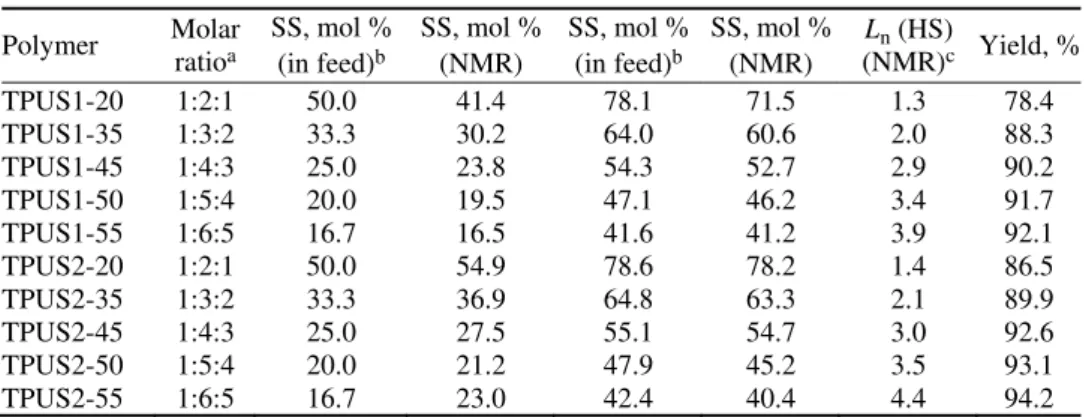

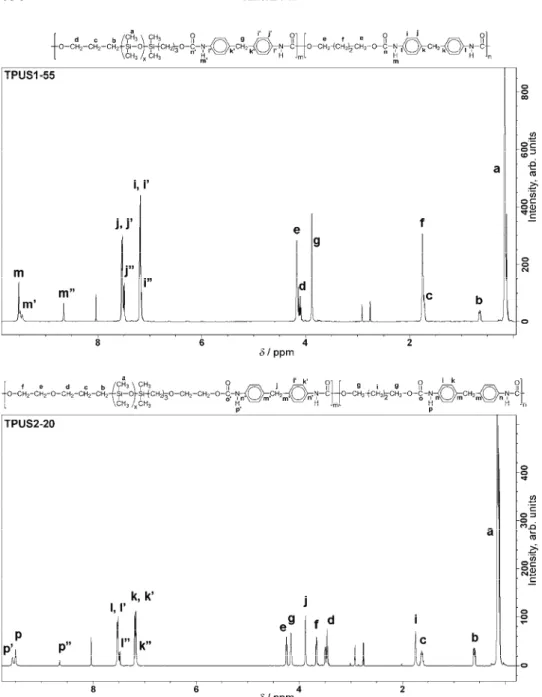
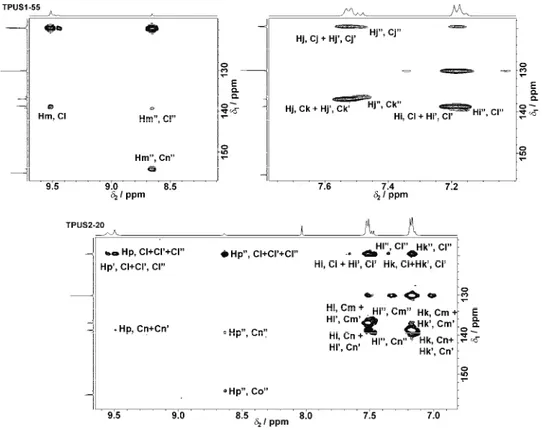
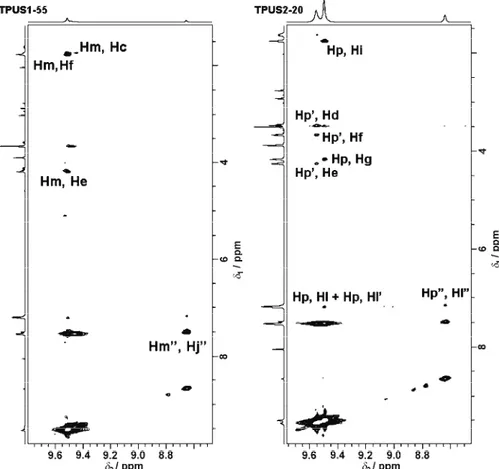
![TABLE II. Results of GPC analysis and intrinsic viscosities of the synthesized TPUSs Polymer M̅ n / g mol -1 M̅ w / g mol -1 M̅ w /M̅ n [ ] / dL g -1](https://thumb-eu.123doks.com/thumbv2/123dok_br/18363772.354473/13.892.175.717.440.628/table-results-analysis-intrinsic-viscosities-synthesized-tpuss-polymer.webp)
